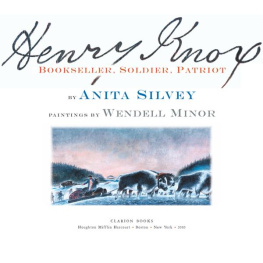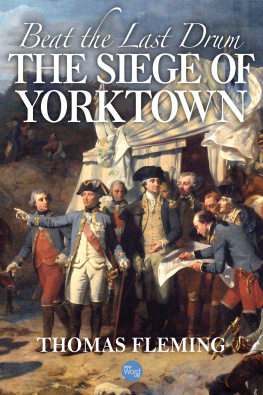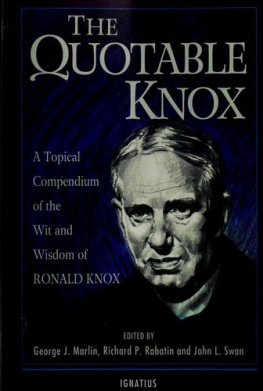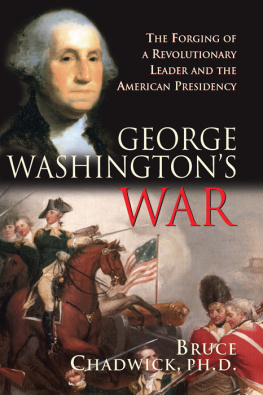
HENRY KNOX
VISIONARY GENERAL OF
THE AMERICAN REVOLUTION
Mark Puls


HENRY KNOX
Copyright Mark Puls, 2008.
All rights reserved. No part of this book may be used or reproduced in any manner whatsoever without written permission except in the case of brief quotations embodied in critical articles or reviews.
First published in 2008 by
PALGRAVE MACMILLAN
175 Fifth Avenue, New York, N.Y. 10010 and
Houndmills, Basingstoke, Hampshire, England RG21 6XS.
Companies and representatives throughout the world.
PALGRAVE MACMILLAN is the global academic imprint of the Palgrave Macmillan division of St. Martin's Press, LLC and of Palgrave Macmillan Ltd. Macmillan is a registered trademark in the United States, United Kingdom and other countries. Palgrave is a registered trademark in the European Union and other countries.
ISBN-13: 9780230611429
ISBN-10: 0230611427
Library of Congress Cataloging-in-Publication Data
Puls, Mark, 1963
Henry Knox, visionary general of the American Revolution / by Mark Puls.
p. cm.
Includes bibliographical references.
1. Knox, Henry, 17501806. 2. Knox, Henry, 17501806Influence. 3. GeneralsUnited StatesBiography. 4. United States. Continental ArmyBiography. 5. United StatesHistoryRevolution, 17751783Campaigns. 6. United StatesHistoryRevolution, 17751783Artillery operations. 7. Military engineersUnited StatesBiography. 8. Cabinet officersUnited StatesBiography. I. Title.
E207.K74P85 2008
973.3'092dc22
[B]
2007037222
A catalogue record of the book is available from the British Library.
Design by Letra Libre, Inc.
10 9 8 7 6 5 4 3 2 1
CONTENTS
For Matthew Puls with great affection
This book has benefited from the generous support and help provided from many sources to a grateful author. I wish to express my thanks, especially to Gerald W. Puls, Sheron Puls, Leslie Rivas-Lynch, Donald S. Lynch, Gabriella Rivas-Lynch, Michael Puls, Noosi Puls, Denise Edwards, Jeremy Pearce, Lisa Zagaroli, Dr. Svetlana Mishulin, Motoko Huthwaite, and Michael Mercatante. I am also indebted to Alessandra Bastagli, editor at Palgrave Macmillan, for her guidance and creativity. I would like to thank Billie Rae Bates for helping prepare the manuscript. I am also thankful for the work of the staffs at several libraries and institutions, especially at the Library of Congress, the Massachusetts Historical Society, the Gilder Lehrman Collection at the New York Historical Society, the Montpelier General Henry Knox Museum, the Museum of Fine Arts, Boston, and George Mason University.
With respect to General Knox, I can say with truth, there is no man in the United States with whom I have been in habits of greater intimacy; no one whom I have loved more sincerely, nor any for whom I have had a greater friendship .
George Washington to John Adams
Nine-year-old Henry Knox entered the Boston bookstore, leaving his childhood behind. The boy, blond and tall for his age, could see shelves of books and boxes of fine stationery adorned with floral designs imported from London, along with writing materials, inkwells, quills, pamphlets, and writing paper neatly laid out for customers. His days of playing with friends or attending school would be replaced with the bookshop's chores and adult concerns over money and the support of his family.
His life had been turned upside down that year, 1759. His father, William Knox, a once-prosperous shipbuilder, left the family after his business collapsed in the midst of economic hard times sweeping the American colonies. Plagued by debt, the disillusioned Knox boarded a ship bound for St. Eustatius in the West Indies, leaving his family with no means of financial support. Henry was left to care for his mother and his three-year-old brother. His older siblings, John and Benjamin, had left home years earlier to earn a living as merchant seamen, never to return to Boston.
His mother, Mary Knox, pulled Henry out of Master John Lovell's prestigious Boston Latin Grammar School, an elite primer for students aspiring to attend Harvard College, and set aside whatever hopes she had for him to offer his labor to Messrs. Wharton and Bowes, who had taken over a fashionable bookshop from Daniel Henchman on the south side of Boston. Taking pity on the family, Nicholas Bowes agreed to hire Henry and provide him with whatever paternal attention and moral guidance the now-fatherless boy needed. Mary took solace that her son could continue his education in a bookstore, in an atmosphere of literacy and learning, frequented by the most educated and influential people in Boston.
His employers showed Henry around the store and pointed out the books that might be helpful in furthering his educationvolumes on mathematics and history, Greek and Latin classics, and literaturetelling him that he could take any home to study. His employers said they would tutor him in the craft of binding and repairing books and teach him everything about the trade. Henry was then put to work, running errands and doing chores around the shop, helping customers, and making deliveries.
He had been saddled with substantial responsibilities, but Henry accepted his role as provider with a secret pride, believing he needed not only to save his family from financial ruin but to reverse its downward spiral. The once-proud Knox name was still revered in Scotland, where his ancestors had descended from nobility. His lineage could be traced to William Knox, lord of Gifford, a manor near Edinburgh in the Scottish Lowlands. William had been the older brother of John Knox (15141572), the renowned Reformation preacher who furthered the Protestant movement in Scotland, turning the country predominantly Calvinist and gaining the enmity of the Catholic monarch, Mary Queen of Scots. Religious conflicts between Catholics and reformers drove many Scotch Presbyterians, including Henry's family, to resettle in Northern Ireland.
In 1729, Henry's father, seventeen-year-old William Knox of Derry, Ireland, a town near Belfast, sailed to America with a congregation led by the Reverend John Morehead. Reaching Boston in 1730, they established the Church of Presbyterian Strangers on Bury Street. The first names on the church's baptismal records were Knox and Campbell, the families of Henry's father and mother. William was a shipbuilder and merchant, and construction yards for vessels thrived along Boston Harbor. Because lumber and labor was plentiful in America, ships could be built 20 to 50 percent cheaper than in England. The colonies would soon produce a third of all British ships.
William bought a wharf along Boston Harbor to dock imported goods, a construction yard, and a picturesque two-story, wood-sided home with a gambrel roof and two fireplaces on Sea Street (later renamed Federal Street), near Summer, that overlooked the harbor. A picket fence bounded the property, and a garden provided vegetables.
When William began his courtship of Mary Campbell, his future looked promising. The couple exchanged wedding vows before the Reverend More-head on February 11, 1735. Henry was born in the family's prosperous home on July 25, 1750, the seventh of ten sons, of whom only four survived to adulthood: John, Benjamin, Henry, and his younger brother, William. An energetic child, Henry was fond of playing with toy soldiers. He and his boyhood friend, David McClure, who later became a prominent Connecticut clergyman, were intrigued that a man had tried to "fly" by jumping from the steeple of Boston's North Church, in what may have been an early demonstration of parachuting. The boys climbed to the roof of a small building owned by Henry's father and slid down a long ship oar to feel the sensation of an airborne flight.
Next page











